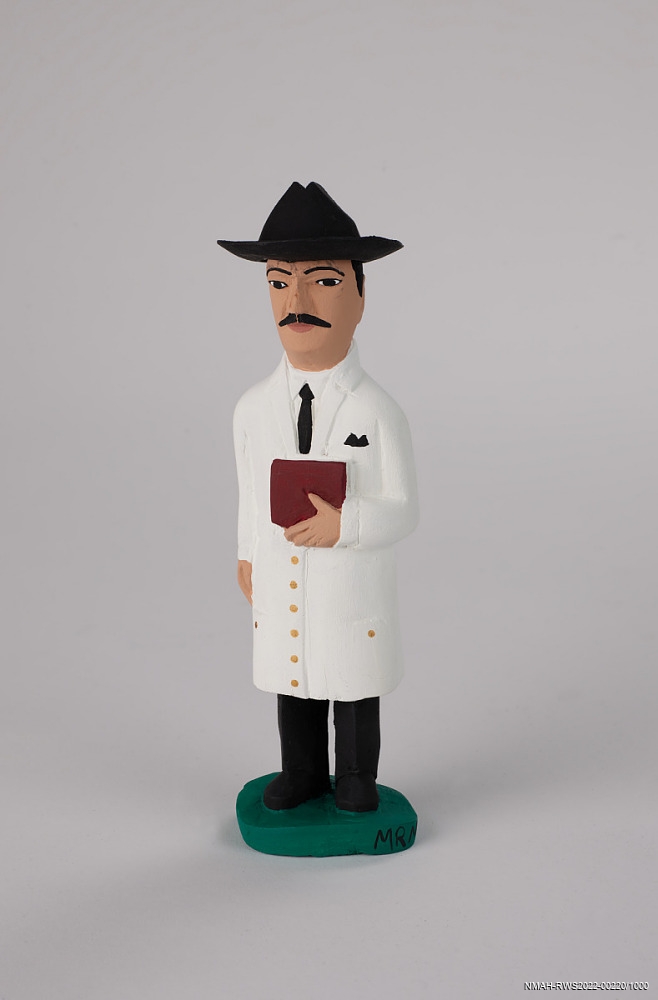D.C. Community Clinic Objects Highlight Philanthropy in Smithsonian Exhibition

Venezuelan folk sculpture of José Gregorio Hernández, a late 19th- and early 20th-century physician who became a symbol of health-care charity.
The Smithsonian’s National Museum of American History will update its “Giving in America” exhibition Sept. 6 to include objects related to the history of Mary’s Center. The center began in 1988 as a Washington, D.C., clinic dedicated to providing medical care to women fleeing violence in Central America, many of them victims of trauma that resulted in pregnancy.
“Giving in America” is a long-term exhibition that looks at the history of philanthropy’s role in shaping the United States. The exhibition is part of a larger project, the Smithsonian Philanthropy Initiative, launched in 2015 to explore philanthropy’s collaborative power. It includes a curatorial focus on collecting, researching, documenting and exhibiting philanthropic materials and convenes conversations that bring historic perspectives to contemporary issues in philanthropy.
Founded by Maria Gomez, a public health nurse, a large Mary’s Center wall sign will be a focal point of the updated philanthropy exhibition’s new case, “A Story of Community.” Paired with the sign will be various photographs from the clinic, protective equipment worn during the COVID-19 pandemic and a Venezuelan folk sculpture of José Gregorio Hernández, a late 19th- and early 20th-century physician who became a symbol of health-care charity. Mary’s Center pediatrician Maria Marquez kept this figure by her front door to inspire her on her way to work.
“The ‘Giving in America’ exhibition is an integral part of the museum’s mission to inspire people to participate in the shaping of our future, with the Mary’s Center story showcasing how a community can come together to address a healthcare crisis,” said Anthea M. Hartig, the Elizabeth MacMillan Director, National Museum of American History. “This exhibition aims to encourage visitors to give their time and use their talents to serve in their communities and build a more equitable future for all.”
Gomez, who herself fled violence in Colombia decades before, recognized a critical need as nearly 200,000 migrants from Central America arrived in Washington in the 1980s. With vulnerable legal status, many avoided seeking government services and assistance. The clinic began in an Adams Morgan neighborhood basement office with financial support from the community and the local city government. In more than 35 years of community service, Mary’s Center expanded to multiple locations and evolved to meet new needs, including education, workforce development, social services and specialized services in support of the LGBTQ+ community. In 2012, Gomez received the Presidential Citizens Medal from President Barack Obama.
“Giving in America” Exhibition
The “Giving in America” exhibition centers around four major questions of American philanthropy: “Who Gives?” “Why Do We Give?” “What Do We Give?” and “How Do We Give?” New artifacts will be added to these sections, including the gold pocket watch worn by businessman and philanthropist Julius Rosenwald, dating from the 1870s. Rosenwald gave millions for Black education and Jewish causes in the early 1900s. A water bottle and a bingo board from a Seattle school fundraising alliance established by parent-teacher groups who were concerned about the way fundraising reinforced wealth disparities in schools will also be in the “How Do We Give?” section.
The “Who Gives?” section will feature an 1887 charity ball magazine illustrating how Jewish New Yorkers melded ancient tradition with modern philanthropy by holding charitable fundraising balls during the Purim festival, which celebrates Jewish survival and promotes philanthropic efforts. Chinatown Health Fair buttons from the early 1970s in New York City represent a movement spearheaded by young Asian American activists to improve access to health care for underserved communities. The activists’ efforts resulted in the establishment of an influential community health center in the city.
Letters by signers of the Giving Pledge, a commitment by the world’s wealthiest individuals and families to dedicate the majority of their wealth to philanthropy, will be on view. The fall display will include letters from Ric Elias, co-founder and CEO of Red Ventures, and Brenda Elias; Bill Gates, co-founder of Microsoft Corp., the Bill & Melinda Gates Foundation and the Giving Pledge; William (Bill) Gross, co-founder, former managing director and CIO at PIMCO; Nat Simons, Meritage Group founder, and Laura Baxter-Simons, Meritage Group general counsel and chief compliance officer who co-founded Prelude Ventures and the Sea Change Foundation and Byron Trott, chairman and co-CEO of BDT & MSD Partners; and Tina Trott. In addition, visitors can peruse over 170 Giving Pledge letters on an adjacent kiosk.
About the Philanthropy Initiative
The Philanthropy Initiative is funded by the Bill & Melinda Gates Foundation and David M. Rubenstein, Smithsonian Institution Regent emeritus and co-founder and co-chairman of The Carlyle Group. Federal funds through the Latino Initiatives Pool administered by the National Museum of the American Latino also support the work of Amanda B. Moniz, the David M. Rubenstein Curator of Philanthropy.
About the Museum
Through incomparable collections, rigorous research and dynamic public outreach, the National Museum of American History seeks to empower people to create a more just and compassionate future by examining, preserving and sharing the complexity of our past. The museum, located on Constitution Avenue N.W., between 12th and 14th streets, is open daily except Dec. 25, between 10 a.m. and 5:30 p.m. Admission is free. The doors of the museum are always open online and the virtual museum continues to expand its offerings, including online exhibitions, PK–12 educational materials and programs. The public can follow the museum on social media on Instagram and Facebook. For more information, go to https://americanhistory.si.edu. For Smithsonian information, the public may call (202) 633-1000.
# # #
SI-252-2024


